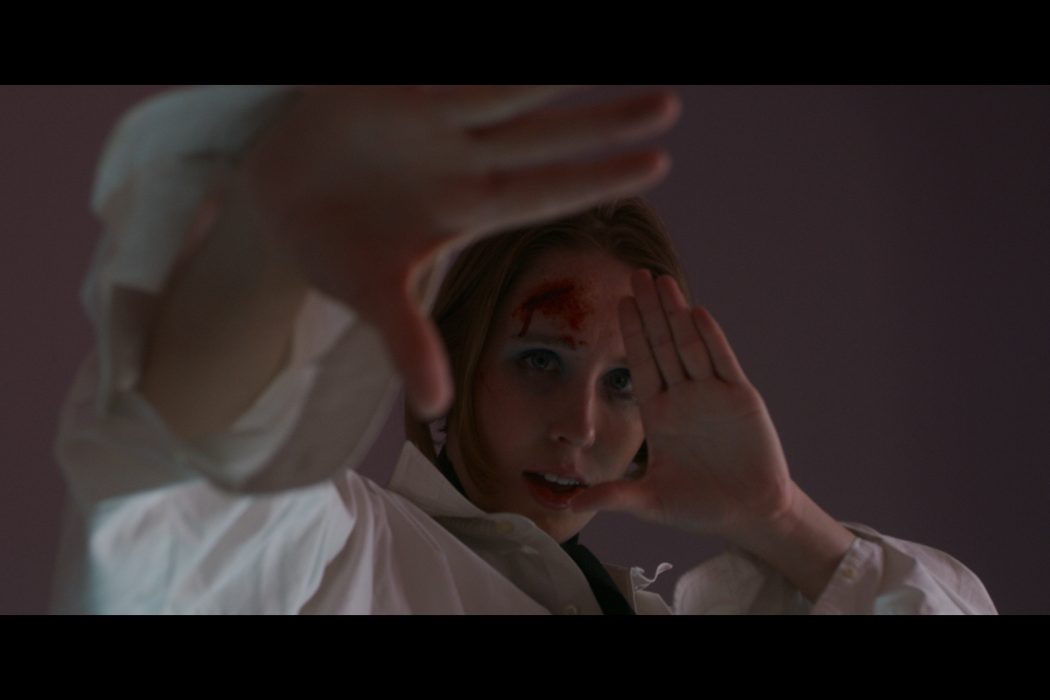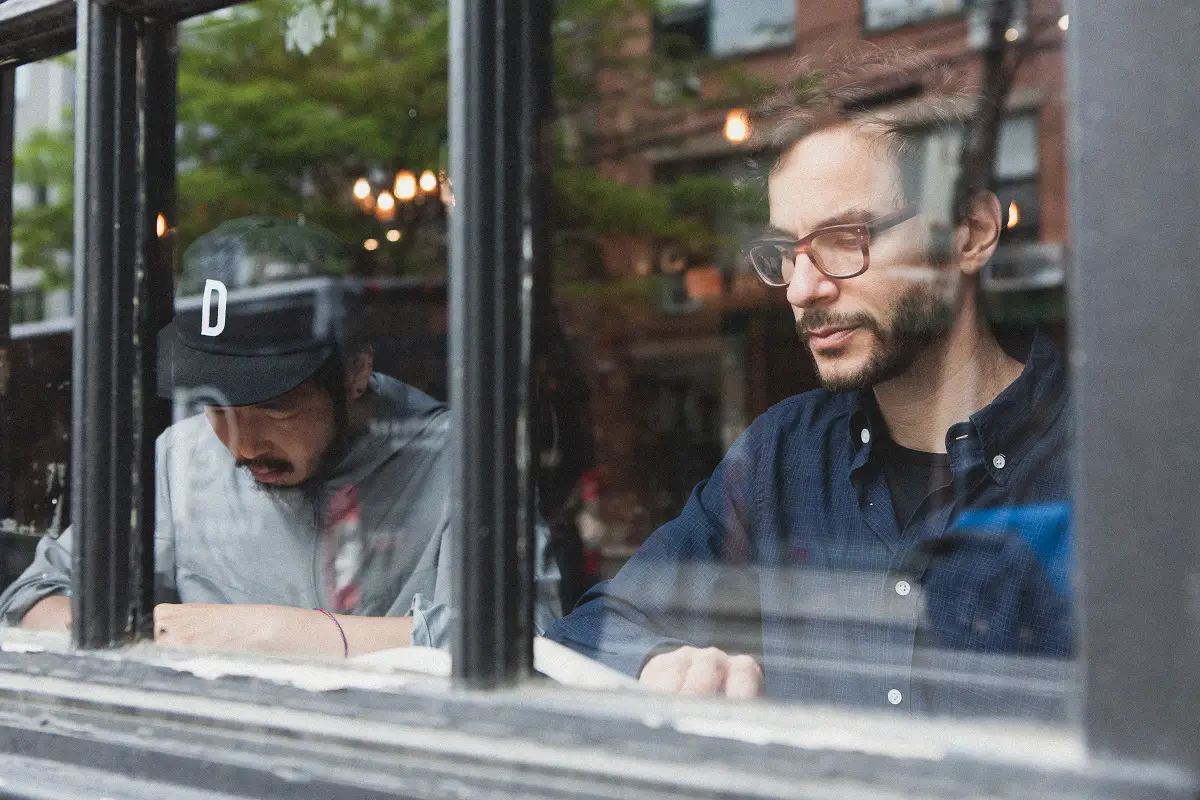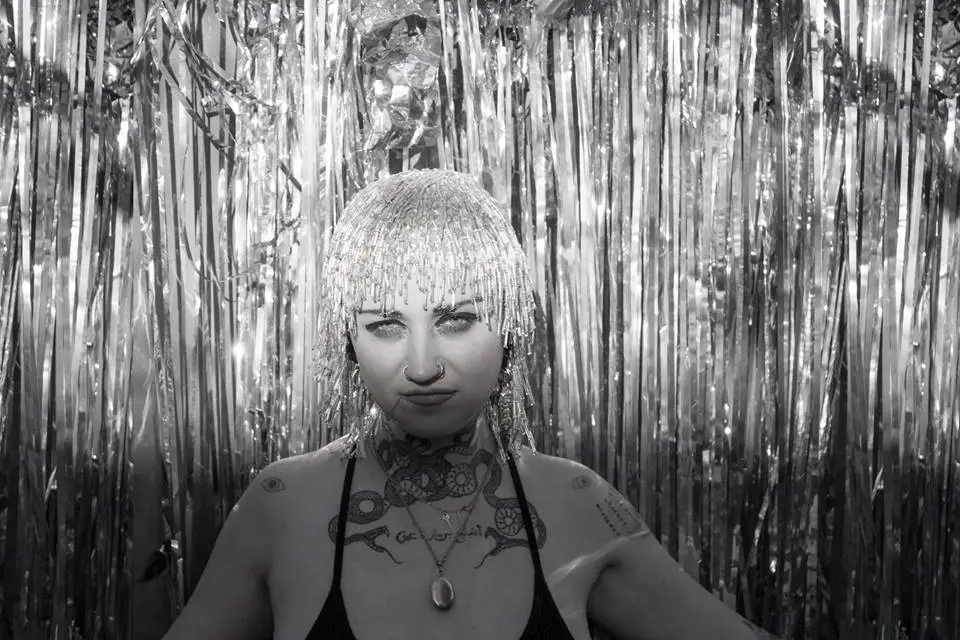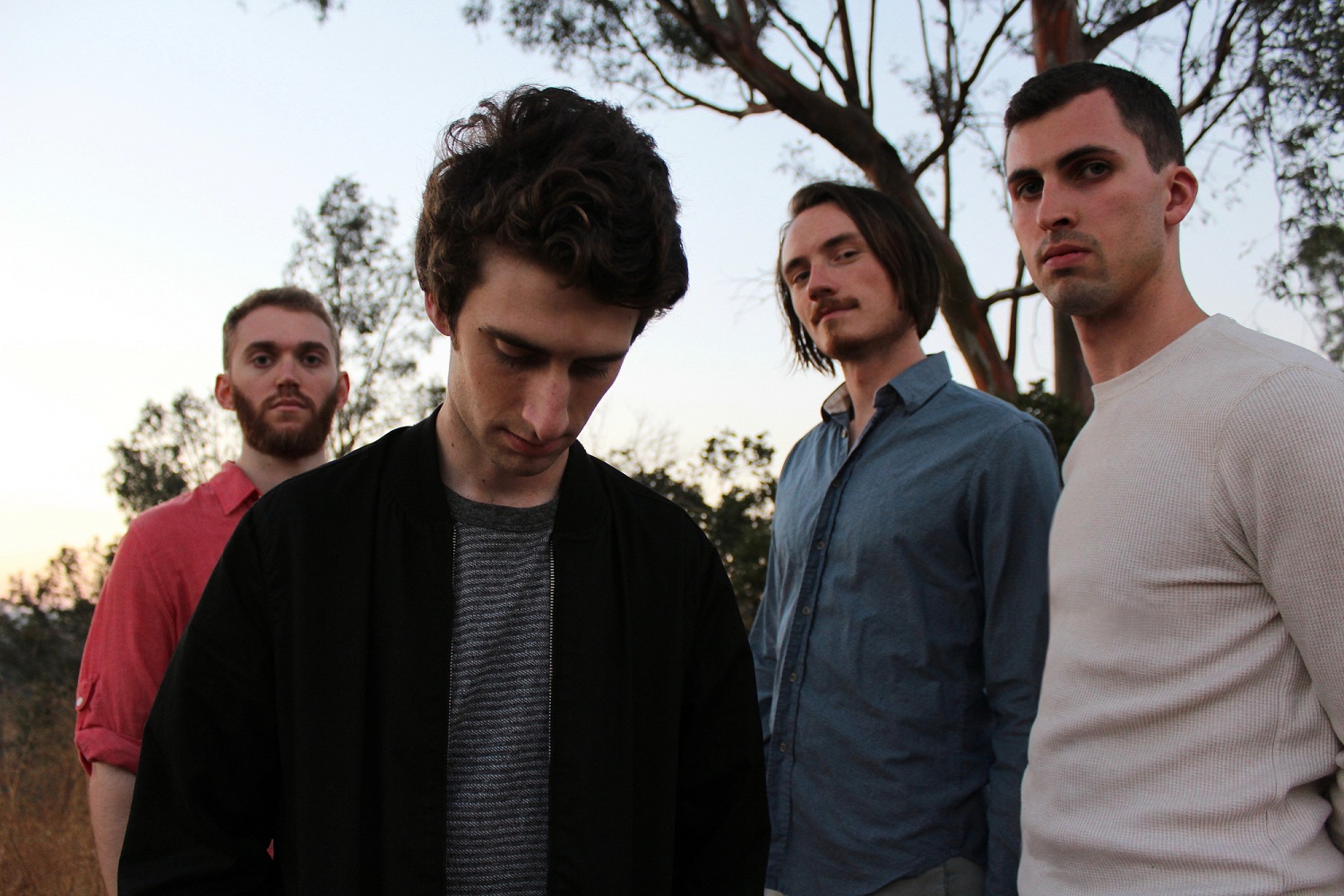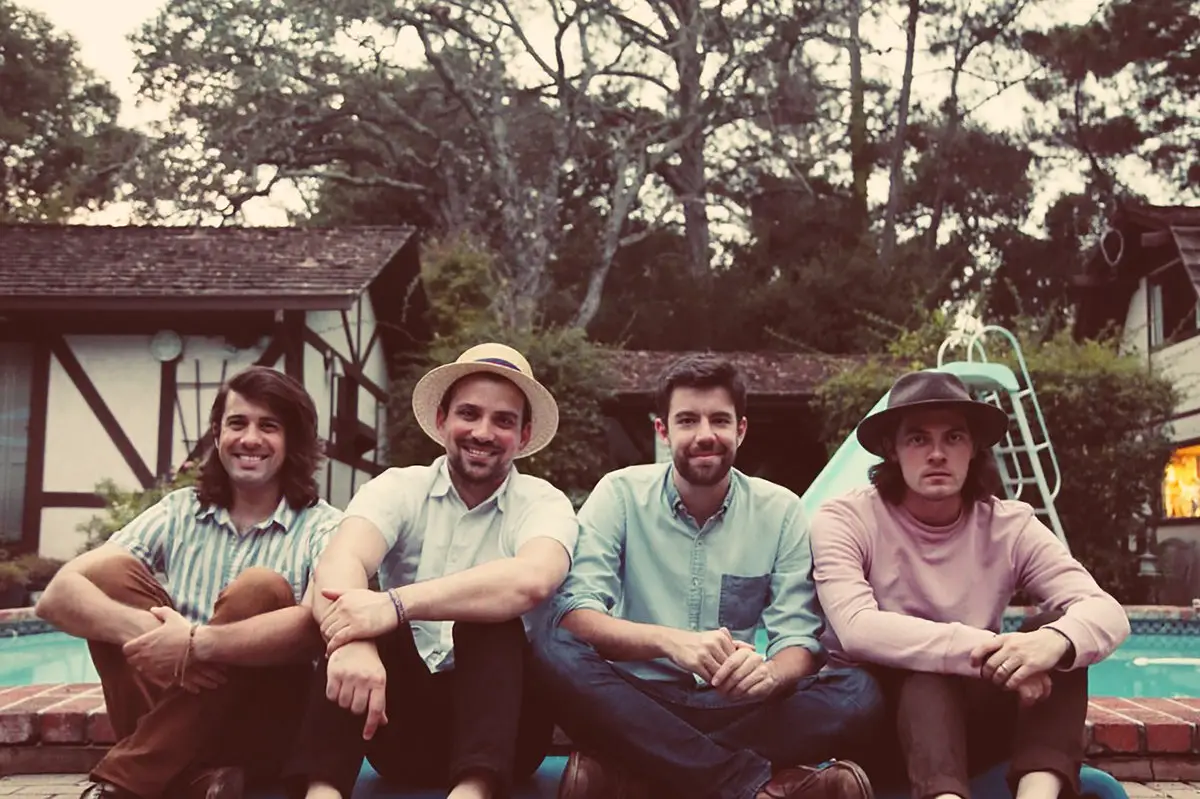Atwood Magazine talked to Softee and Eliza Scanlen about their friendship, the creation of the “Keep On” music video, and how each approach storytelling in different creative mediums.
Watch: “Keep On” – Softee
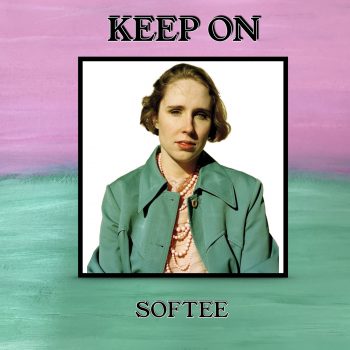
Softee is teasing a new beginning, and she’s doing so by waking up on the floor, post-blackout, gash on forehead, trying to piece the events of the previous night together. The “Keep On” music video, released today, is permeated by flashes of a colourful party, pink walls, and robotic dance, all backed by a synth-heavy and extremely danceable track. By the end of the three and a half minutes, we never quite figure out how we got from a seemingly normal party to bloody bandages and a hazy morning.
The musical alter ego of actor Nina Grollman, Softee has released ‘80s-inflected tracks that deliver fun, dancing, and the best that pop music has to offer. With the promise of her debut album later this year, it was through a creative collaboration with actor and director Ellza Scanlen that Softee found her new direction, one that’s still as much of a mystery as what happened during the fated night depicted in the video.
Grollman and Scanlen first met when they were both cast on Aaron Sorkin’s Broadway adaptation of To Kill a Mockingbird, where Grollman played Scout and Scanlen took on the role of Mayella. Music-filled conversations in between rehearsals and thirty-second meetings during the play amounted to a new creative partnership, with Grollman and Scanlen collaborating for Softee’s new music video. Their visions merged beautifully.
Visually, the result is a trip down memory lane after a blackout, with hues of pinks, purples, reds, and blues inflecting each moment. Grollman, as Softee, is the protagonist, trapped between anxiety, coping mechanisms, and figuring everything out. Scanlen understood the profound feeling of being overwhelmed behind the song’s poppy synths, bringing up nuances in the song that up until then were only known by Grollman herself.
We’re yet to find out what the next phase of Softee looks and sounds like, but both Grollman and Scanlen emphasise how pivotal their collaboration was in informing Softee’s new era. If “Keep On” is any indication, we’re in for a trippy and wonderful ride. Atwood Magazine talked to Softee and Scanlen about their friendship, the creation of the “Keep On” music video, and how each approach storytelling in different creative mediums.
Listen: “Keep On” – Softee
A Conversation with Softee and Eliza Scanlen
Atwood Magazine: You met when you were working on To Kill a Mockingbird, but talk to me a little bit about your relationship and how you started talking about maybe taking this friendship forward and exploring other creative endeavours?
Softee: We became close pretty quickly and we were always fucking around and joking around with each other. We started showing each other our work and other stuff, like I started showing Eliza some music and she was showing me her short film and other projects that she’s done. I guess, we realised like, ‘Oh, we should, we should try to do something while we’re both in the same city and constantly around each other’ and from there I sent her the song and Eliza just immediately had like a million brilliant ideas and thoughts and stuff on it. So then it just became a very easy back and forth from there, because we would just go down to the dressing room, literally in between scenes.
Eliza Scanlen: During the play!
Softee: During the play. I would come down to her dressing room, I had like one break in Act One or something, and I would always come down and we’d literally have a moment where we’d discuss the video and then I’d go back up.
Eliza Scanlen: We had 30 second meetings.
Softee: That’s kind of been the process of developing the ideas for the video, it was just us, between shows or literally in the middle of shows being like ‘So what do you think?’
Eliza Scanlen: Straight away when I arrived in New York, I clicked with Nina. I had come all the way from Australia to live in a new city, I didn’t know many people at all, and to meet Nina was a relief, to be honest. I think the first time we connected was over music, she was sharing some incredible musicians, she had asked me who my favourite musicians were, and I said that I’d been listening to Big Thief a lot recently, and Nina was like “Oh my god I’m obsessed with Big Thief!”, that’s literally how she reacts to everything. From then on we became really close. We also really connected in our goals with our career, I think we both were craving to push ourselves creatively and explore new avenues, and we came from very different trajectories. I think it was only natural that we combined our creative trajectories and made something together. I learned a lot about music from Nina and also about pop music. I feel like since meeting Nina, I have so much more respect for pop music. I think everybody is very quick to hate pop, including me, and I didn’t realise the potential pop music had and how reductive that is as a genre of music, or how people see it as a genre. We’re both hustlers, so we made it happen.
Softee: Right before COVID really hit, we made it happen.
Eliza Scanlen: It was the day before restrictions hit. The day before I flew to Australia.
What was the shooting day like?
Eliza Scanlen: The shooting day was pretty easy. We were shooting in this incredible location, Nina’s girlfriend Tess has this bar that’s opening called purgatory and it’s Bushwick.
Softee: It’s now open. They have outdoor seating now, which is really exciting because they’ve been waiting years honestly. But the inside is like a venue, I don’t know, it just has so many different rooms. You have to just experience it, it’s kind of like a haunted house meets funhouse meets punk-DIY show meets rainbows. But it was such a fun place to shoot because it was such a community space. The crew was also great and Eliza did all that organising and the crew. So it was an easy day. I mean, COVID aside, it was really fun to be with everybody. And then literally in a week everything was shut down.
Eliza Scanlen: I think it was also really special to have it in a place that you’ve seen grow and you’ve watched being built from the ground up. It was kind of perfect for us. So we developed this music video around this space.
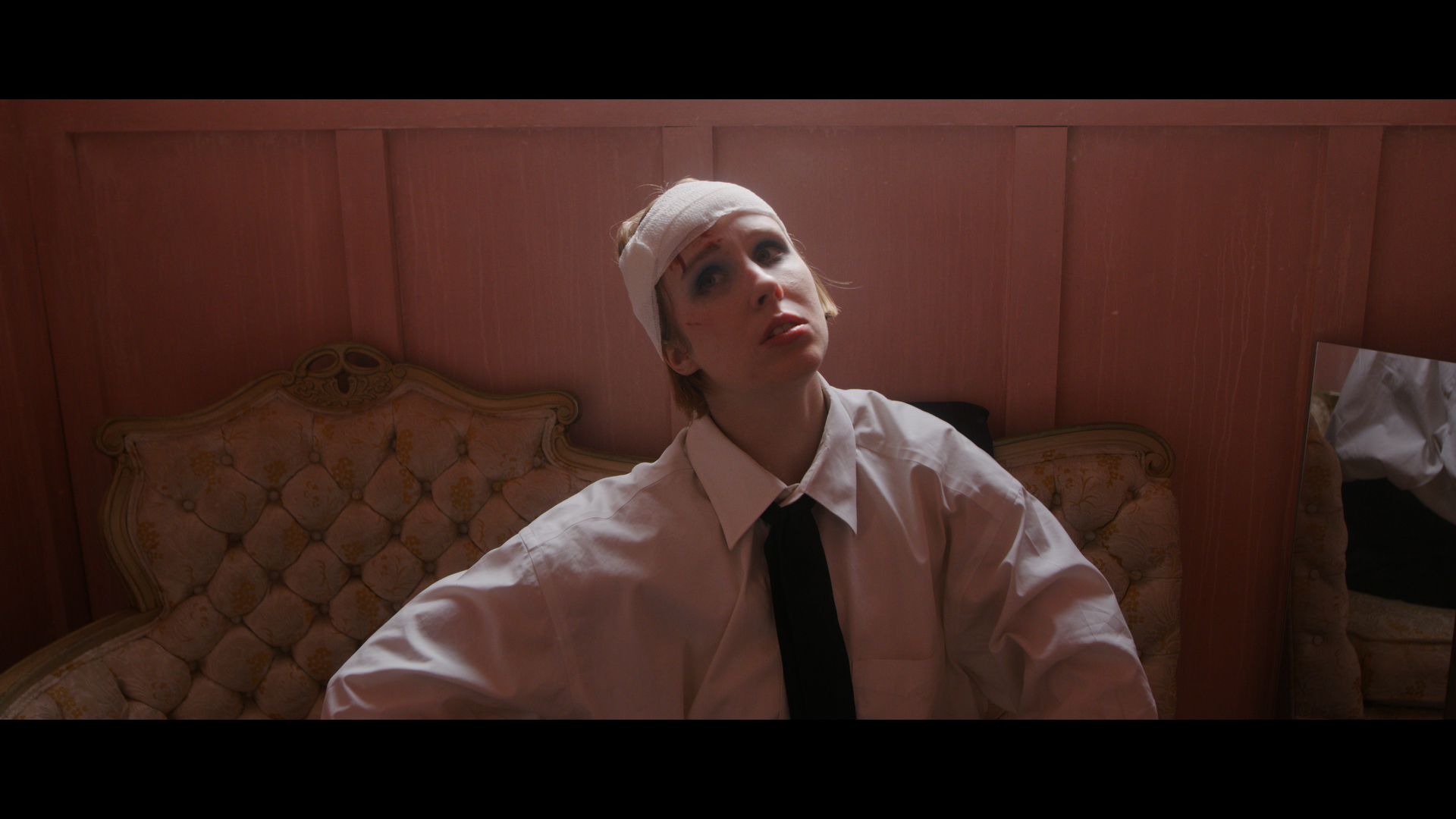
How did you come up with a treatment? Where did the idea come from?
Eliza Scanlen: I’m not quite sure where it originated, but it was extremely collaborative with Nina. I think it begun with what she wanted the new album to be, and how this album is an extension of Softee and how this is new terrain for Softee.
Softee: It helped me clarify a lot of things about about the album. At that point, it was still very skeletal, I hadn’t finished it at all. And then once we really talked about the vision, it became more clear to me. It was a cool thing because I sent you the song and you immediately wrote really nice things, said you really connected to it. You brought a totally different feeling to it then, but at the same time, it married quite beautifully with what I was feeling when I wrote it. The song is basically about how fear of the unknown can manifest in some ways. Like it’s just about things constantly coming at you so quickly, like, you have no way of processing it so it’s just happening around you, and it can be very anxiety inducing and very alienating in your body and out of your body. There’s a whole sequence in the song where it goes instrumental and you hear train sounds and stuff, that part was, for me, the feeling of leaving your body sometimes when you’re in an overwhelming situation, and dissociating in some ways. Eliza immediately articulated a lot of these things to me.
Eliza Scanlen: I think my my job was to just physically manifest those feelings and do that in the space that we were working within, and the location was a really great framework to build this character and build this story. And so it begins with Nina lying on the floor and insinuating that she’s had a big night out. She’s got a gash on her forehead. And when we hit the chorus, she climbs up onto the stage and begins this rather robotic choreography. And to me, the chorus signified, well, at least in the music video, I was trying to allude to this idea of routine rooting somebody in the present, or moving robotically through life whilst everything’s whipping past you uncontrollably and you’re struggling to find your feet. And the only thing you can do is perform what you know. That was the idea. As the song goes into the instrumental, we delve into the night prior, and somehow much she finds her way back to the present. To me, when I listen to the song, there’s a sense of bewilderment at how quickly everything’s moving. And that’s sort of what I wanted to portray, or I wanted to create a story behind that because I’ve never directed a music video before and I guess I’m very story based, so that was the only way I could process it. So it was really interesting seeing how music videos were made because so much of it is visual imagery, and it doesn’t actually have to make sense, so that was kind of freeing.
In the music video you never get the straight answer of how she ended up with a gash on her forehead, laying on the floor. That was interesting, because it starts with this mystery, but the mystery ends up unsolved. Why did you choose to leave it open-ended?
Eliza Scanlen: I think that’s just a classic metaphor for life. I don’t think anything can be solved, and if you do think you have it figured out, it’s an illusion. I think that’s just a symptom of people trying to console themselves and make themselves feel in control, and I think so much of this music video is about losing control and realising that the ways in which you can try and control your thoughts or your life is ultimately not going to fix anything. So I think that at the end of the film there’s this really wonderful catharsis, and that was really important, when we were developing the music video there needed to be a kind of catharsis and like a celebration of that. So yeah, we fucked around a lot.
Softee: I do remember going back and forth about like, do we show like why I got the gash on my forehead? But I do think leaving it open was cool because it is like that feeling of, when you do blackout, you don’t remember everything, you have a highlight reel in your head or flashes of stuff but you don’t have the full picture. So I think it’s kind of cool that you brought that up too because yeah, I’ve gone back and forth about it, but I think it is kind of fun to let everybody just imagine how that happened.
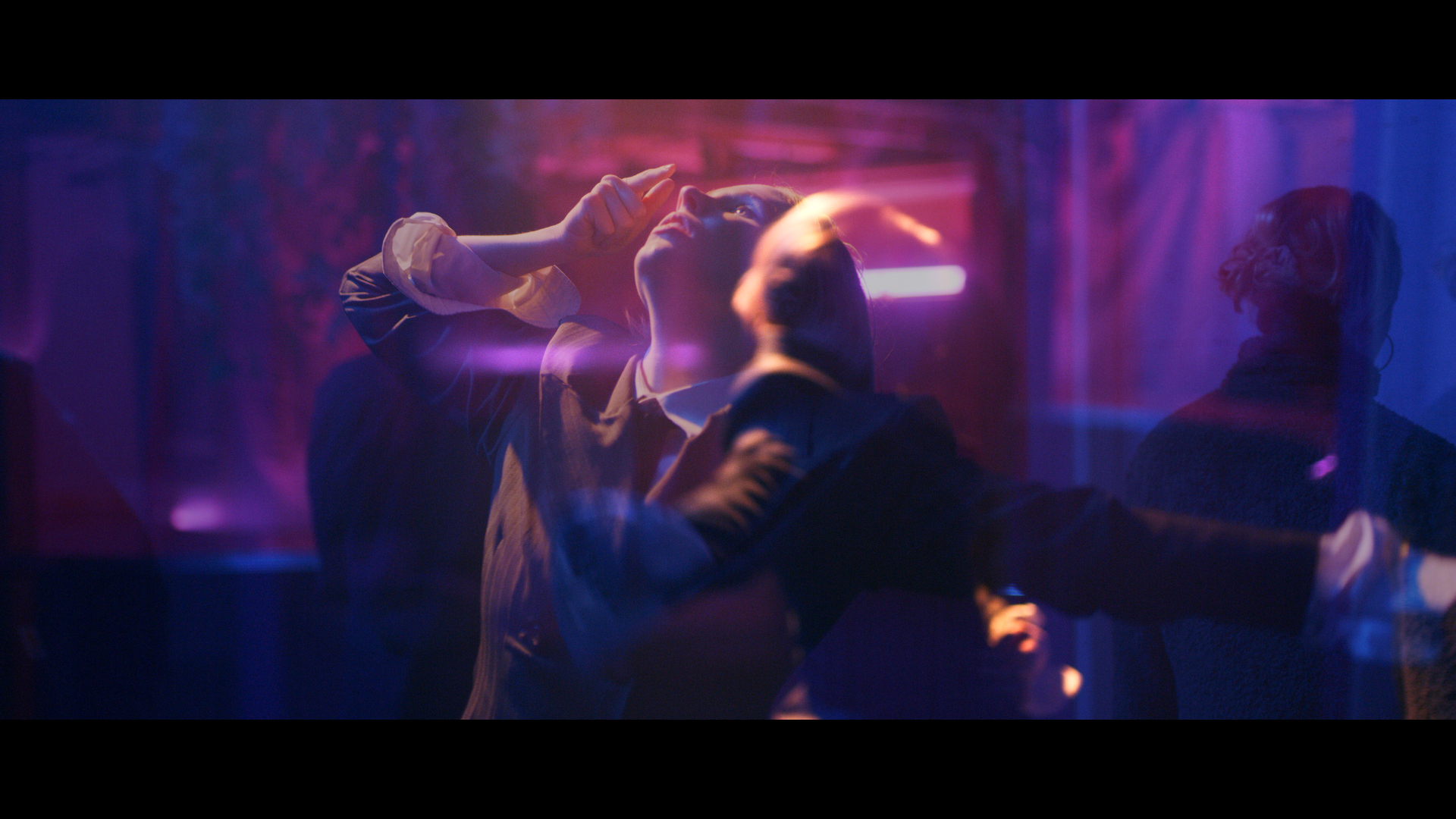
Nina, when did you decide that you were going to trust Eliza with the music video’s vision, and what was it about her that made you decide she was going to direct the music video? And Eliza, what was it about Nina’s music that made you want to try and direct a music video?
Softee: After Eliza showed me her short film, a draft, I was just so blown away by it and from there I was like, ‘Wow, she’s amazing, so talented, and so smart’. With a lot of people that I think are talented and smart. I’m like, ‘Let’s collab!’ and most of the time, they’re like, ‘Okay, sure dude’ and this time it happened to work in my favour. We’d had like conversations, casual ones, when we first met and knew that I did music and she was a director that oh, maybe some day we could do a music video together. But then as time went on, we were like, ‘We should really do that’. We were getting kind of restless. I think the the real decision to actually do it was in the middle-ish of our run, and it was like, ‘Well we don’t know what the future holds, I don’t know if Eliza’s moving or where she’s gonna be after the contract ends’ so it was like maybe we should do a during the run, like now or never kind of thing, and then from there it just immediately materialised. We were just like ‘Okay let’s make a plan, let’s think about this’. Eliza’s a Capricorn too, so she’s very organised and on top of a hustle and she was like, ‘Okay, let’s make it happen, let’s do it, let’s set up the crew’. So that was that was really nice, I didn’t, I didn’t actually have to do that much.
Eliza Scanlen: Besides make a really fucking good song! I’m at a point in my career where I’m really craving new experiences to push me. What I enjoyed so much about New York was that there were so many opportunities to meet people like me who wanted to do the same thing and actually had the drive to get it done. Maybe it was something to do with the city and how fast-paced it is, but I just wanted to make it happen. And I think Nina and I, at this point in the run, we were getting quite restless and you know, we’re doing eight shows a week. I hadn’t worked on a set for a long time, and I really missed it. I thought that it would just be a really wonderful chance for us to put our creative energy into something other than the show. I think that only made the experience of To Kill a Mockingbird even better because working on a play for that long is so hard, it can get quite monotonous, and having another avenue to explore creatively, in some ways, informs the other experience. It was just really creatively fulfilling in the end, and I thought that Nina was one of the coolest people I’ve ever met when I first met her. I just thought it was so cool that she is so young and she’s already made an album, and she’s on fucking Broadway, and here she is being a popstar too, and she had no hesitation and I thought that was really inspiring. I thought that that could be a really cool collaboration. Softee, as a musician, I felt really honoured to in some way find that new voice that Softee has, somehow be a part of it. And it was fun creating a character, because musicians are characters. I don’t think I ever quite realised that.
Softee: In the pop world it can be so fun to develop that kind of alternate persona. Softee’s debut EP was bright, and I was still trying out a lot of stuff, very bright and 80s and sparkly. But this album is, I don’t want to say darker, but it’s definitely me spreading my wings a little bit and I feel like working on the music video especially helped me, talking through it with Eliza, helped me so much establish a clear voice and point of view for where I wanted the whole album to go. Which was, I guess a little more introspective, while also being really danceable, and still pop music.
So much of your music is very ‘80s influenced, at least so far, I don’t know what's next for the new phase of Softee. What is it about the ‘80s, or the sound of the ‘80s, that you want to evoke today?
Softee: I’ve always been into it, I grew up on Stevie Wonder, the 80s period of Stevie Wonder, that was my whole childhood. I’ve always has been naturally attracted to it. But I think ultimately it’s the bigness of it, the drama, the fun, and the unabashedly campy nature of it in some ways. It’s so theatrical, it’s so massive and there’s no holding back, it’s just feelings and drama and the synths. Synths were totally being used in a new way that like, I’m a synth head, so I’m just obsessed with finding great synths and that’s the golden period for me, that’s like the Golden Age. I love the 80s, I’ll always love 80s music, but I’m kind of going in new directions with this, I’m sort of stepping into the 90s a little bit, I’m not gonna lie, no shade to the 80s.

Eliza, you'd directed a short film before, but as you said, you’d never directed a music video. So how do both experiences compare as a director, what were the challenges? What did you find surprisingly great or surprisingly difficult about the music video directing experience?
Eliza Scanlen: I think when I got onto the set and we started working, we were doing our first shot of the day, and it was done in like 10 minutes and I was sort of just like, ‘Is this it? Do we move on?’ and the crew were like, ‘I think so!’ ‘Okay, let’s move on!’. In my other experience of directing a short film, there’s a narrative and there’s continuity and there’s actors talking at each other,, you need to put the mic in, it’s just a lot more stressful than making a music video. That part of making a music video was really easy. But the challenge for me making this music video is that I think my strong suit is character work and dialogue and scene work, and I haven’t really given much thought to what my visual voice is, I don’t know if that’s because I haven’t made enough films yet to know, but I look at other music videos and I go, ‘Holy fuck, how did they think of that?’. Or it’s something so simple, it’s like one shot and it sustains the whole song. I now see that as so brave to just, for example, have one shot that allow that to be a whole music video. And there’s something really groundbreaking in doing that. So I think for me, the challenge of this was trusting my instinct and allowing myself to relax into the visual imagery because usually I’ve been more focused on a character or a storyline.
Are there any questions that you’ve always wanted to ask each other and didn’t have the chance to? And if so, could you ask them right now?
Eliza Scanlen: I’ve got one. Because you’re my only musician friend. I remember when we were doing the show, Nina bought this shitty Casio synth, a cheap little keyboard from the two dollar shop, and she just started making beats on it. And I was so amazed at how she could do that, how she could make a really good song out of a crappy old keyboard. So my question is:
Eliza Scanlen: How do you know when a when a chord progression is good?
Softee: Oh man. A chord progression I’d say that’s all feeling. Actually the test would be not getting sick of it, if you can play it over and over and over again and you’re still into it, like really into it, then then that’s how you know – same with melody. Lyrics are a little trickier. Lyrics usually come a little later for me. They’re not typically the first thing I start with when I write. For melody, chord progression, beat, or however I start, it’s usually if I can listen to it over and over again and be like, ‘Yes, ’m still feeling this’, I’ll make something, I’ll sleep on it. I’ll wake up in the morning and if I still like it on my morning walk, I’ll be like, ‘Alright, I’ll go with it!’
Eliza Scanlen: So interesting because when I listen to music and I can recognise the technicality of the music and why some songs are so satisfying. But for you it’s just all in your body. It’s so natural for you, which is really cool.
Softee: Oh, you’re making me blush.
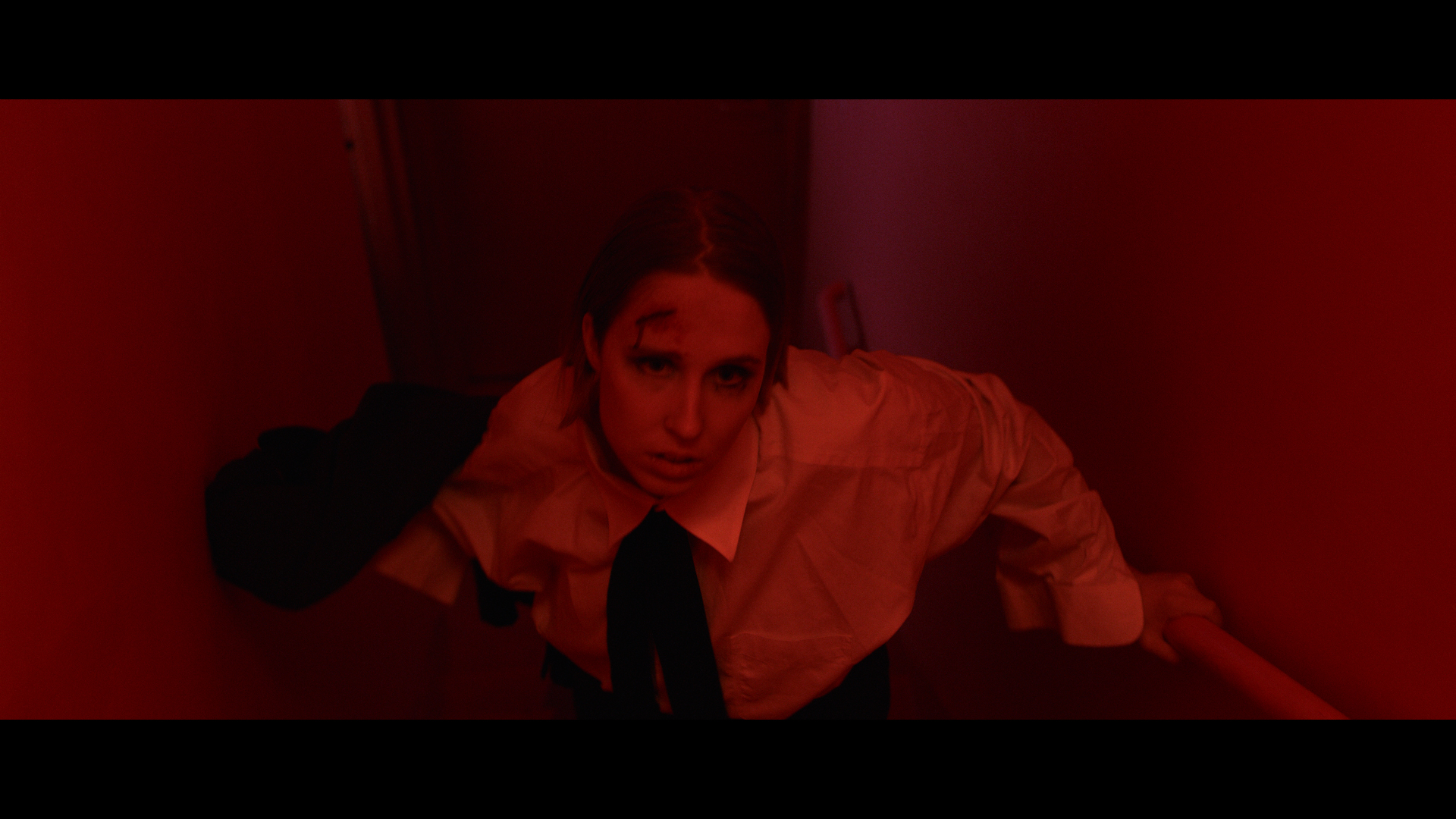
Softee: Okay, my question for you. When you’re directing: do you have to separate yourself? Is it hard, I guess, when you’re talking to the actor about the scene, to not go into actor mode? It’s amazing to me how you can be such an amazing actor, but also have a way of commanding a set, and letting others actors find their character themselves and not take over that process. Let’s say I’ve worked with directors who are also actors and can get a little micromanage-y. How do you manage, when you’re in the director's shoes, to give direction to the actors?
Eliza Scanlen: I direct how I want to be directed obviously, and I have to protect my space when I’m acting. I love having conversations with the directors about the characters, but not on set. It has to be in the rehearsal process or in the development process and there can be some talk of it, but not when we’re doing a scene. I think by the time I get on the set I want most of the character work to be done. [As a director] I think my job on a set is to exude calmness and tranquility so the actors can relax. There’s something really special in just taking an actor aside and having a gentle conversation with them about where I want the scene to go. Iit’s actually really hard to hold back the urge to say, ‘Just say it like this, that’s how I want it to be said because as a story that tone is really important for the pacing of the film’. But you can’t say that because it annihilates an actor’s confidence. So I think a lot of what directing is, is just is holding back the urge to tell the actor the result you want and finding a way to get them there and making them feel like they’ve done it on their own. Because that only gives them more confidence to explore.
Softee: Now that you’ve directed more, when you’re on set as an actor, do you think that’s given you insight into their mindset?
Eliza Scanlen: Totally. And I think that I can really see it now, how vulnerable actors are, especially in specially when we’re exploring really dark subjects. So I think it’s just so important to be gentle with them and check in on them and say ‘How are you going? Is this okay for you? Is there anything I can get for you?’ I think the more the director is trying to facilitate the actor, the more they feel like they’re part of the story, it’s really important to make an actor feel like them that they are meant to be there and their opinion matters. I think for anything now, making the music video too, it was beyond my directorial vision, it was really you that was directing, in a way. It’s your story, and I just wanted to facilitate that.
— —
Watch: “Keep On” – Softee
— — — —

Connect with Softee on
Instagram
Discover new music on Atwood Magazine
? © Alex Hass

